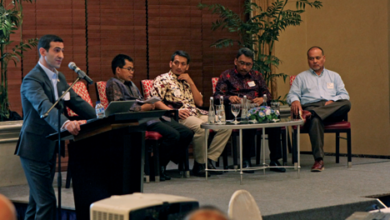Cloud-computing, sophisticated models enhance meaning of downhole drilling data
By Katie Mazerov, Contributing Editor

Collaborative use of real-time telemetry to more effectively utilize the massive amount of data that is now available at the wellsite has been instrumental in taking drilling optimization to a new level in the past five years, according to David Johnson, VP, Research and Innovation for Petrolink. The company provides real-time data infrastructures that help operators and service companies manage and correctly use relevant information to analyze various drilling parameters, such as well hydraulics, torque and drag, vibration, bit selection and drilling fluids and rheology.
“Economics has been a key driver in the shift from a focus on improving efficiency and drilling faster, to one that effectively and safely maximizes resources and minimizes costs,” Mr Johnson said. He co-chairs the Wellsite Information Transfer Standard Markup Language (WITSML) drilling data standard group at Energistics, a nonprofit agency that is the custodian for data standardization in the oil industry. “We’re seeing a surge in the need to collect, manage and standardize drilling data so that it is available on a moment’s notice for analysis for understanding and lessons learned. The US unconventional market had a big say in this trend, but now we’re seeing it go worldwide.”
The capability to apply analytics on top of the data is enabling drillers to understand what the information means. “In many cases, clients ask us to help them marry a technology they have developed and understand with the mountain of information we have collected, a collaboration that becomes quite powerful,” he said. “By running huge amounts of data through analytical routines, operators can gain answers and see trends to help them reduce costs.”
The ability to store huge amounts of data in real time is another step-change that helps drillers quantify and prove what they think is occurring downhole. “The oil industry has always had large data sources, such as seismic and earth models, but the data gained while drilling has traditionally only been collected in snapshots due to cost,” Mr Johnson pointed out. “However, with cloud-computing, massive parallel infrastructures and distributed data models, we now have a whole new way to cost-effectively store drilling information that is easily accessible.”
Petrolink is the process of launching an upgrade to a class of technologies based on cloud-computing and distributed data models that will enable infrastructures to handle significantly more data. Field tests for the upgrade began in December on hundreds of live wells in the Middle East, one of the company’s biggest market.
An important objective for operators is identifying and reducing inefficiencies that lead to nonproductive time (NPT). “It is the stated goal of some of our clients to reduce NPT through data infrastructure and analytical processes that we put on top of infrastructures, and the reduction we are shooting for is 2-3%,” Mr Johnson said. “That goal is best achieved with an open exchange of drilling information that is standardized and completely accessible. A prime challenge we face when working with multiple service providers is that each of those providers has information but no one has the complete picture.”
To that end, “WITSML allows any number of providers involved in a drilling activity to share information without sharing the technologies that drive their proprietary systems,” he said.
WITSML is a trademark of Energistics.




